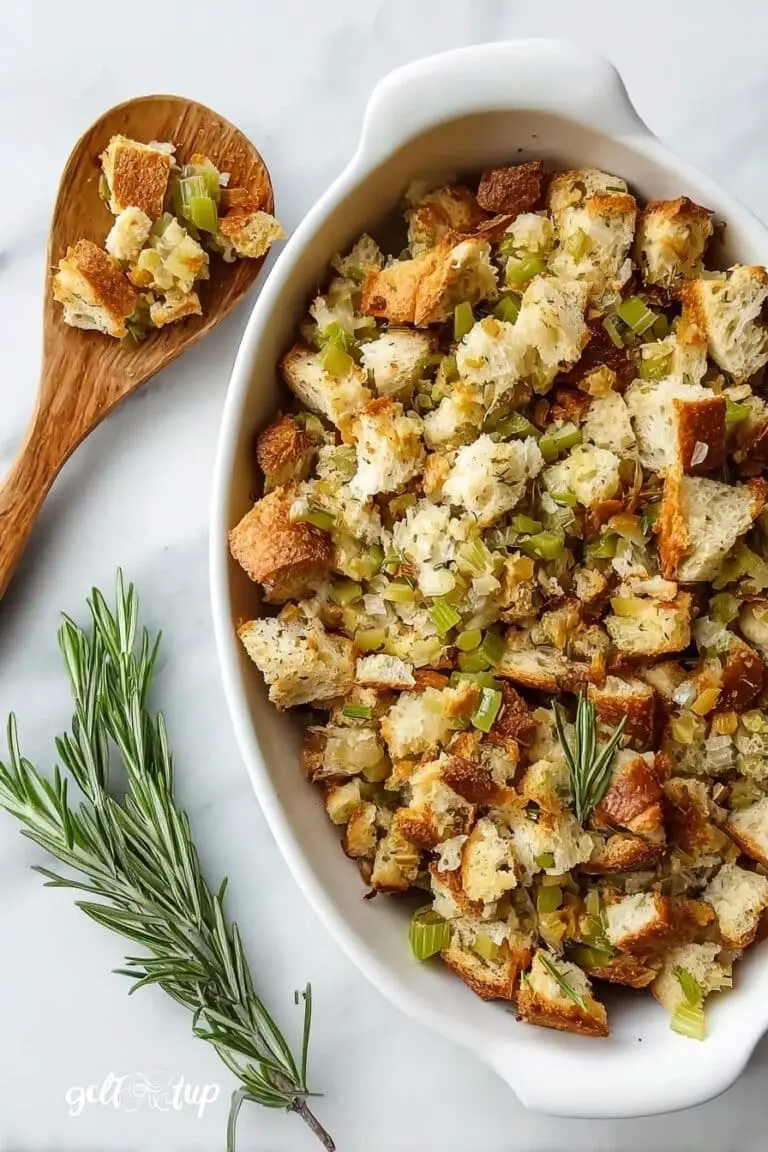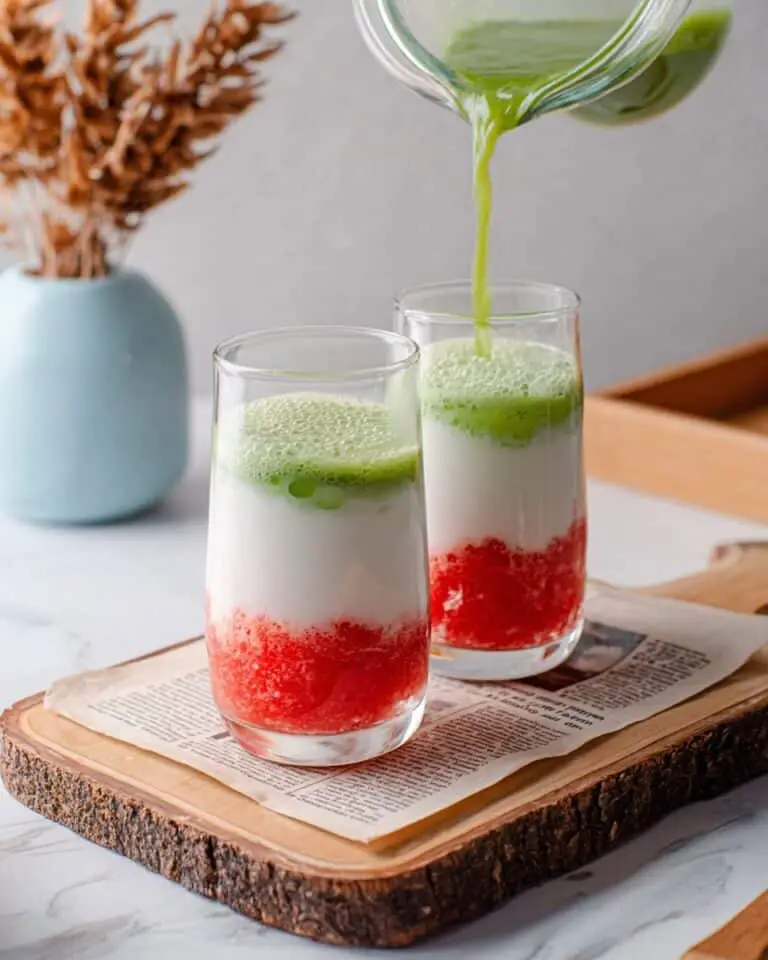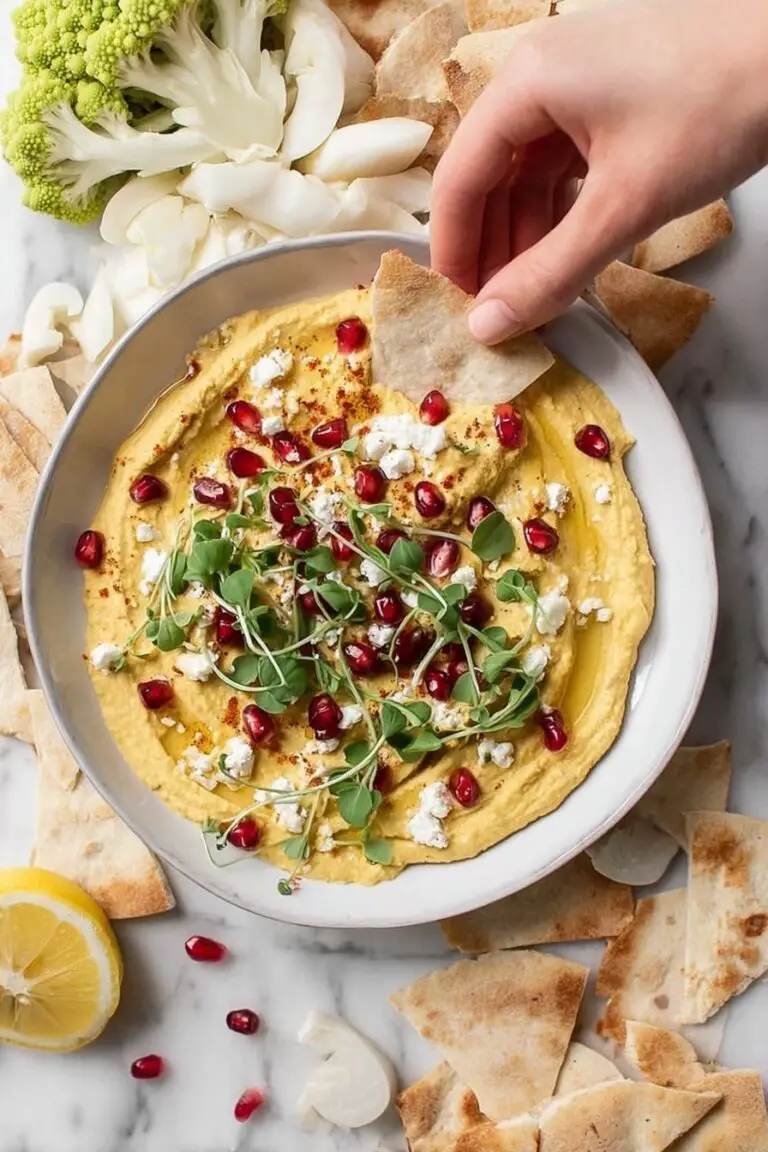Lebanese Fattoush is one of those salads that turns even the simplest meal into a total celebration of fresh flavors and textures. With crisp pita “croutons,” vibrant veggies, and an irresistible lemony, sumac-tinged dressing, every bite is a burst of sunshine. If you’ve never had Lebanese Fattoush, get ready: this recipe will absolutely win over your heart (and your taste buds)!
Why You’ll Love This Recipe
- Bursting with Texture: The combination of crunchy pita chips, crisp vegetables, and juicy tomatoes keeps every bite lively and exciting.
- Bright & Zesty: Authentic Lebanese Fattoush dressing features lemon juice, pomegranate molasses, and sumac for a tangy zing that just wakes up your palate.
- Simple, Wholesome Ingredients: You likely have most of what you need on hand—and it’s naturally vegetarian and can be easily vegan, too!
- Perfect for Sharing: Generous, family-style servings make this recipe ideal for gatherings, potlucks, or weeknight dinners.
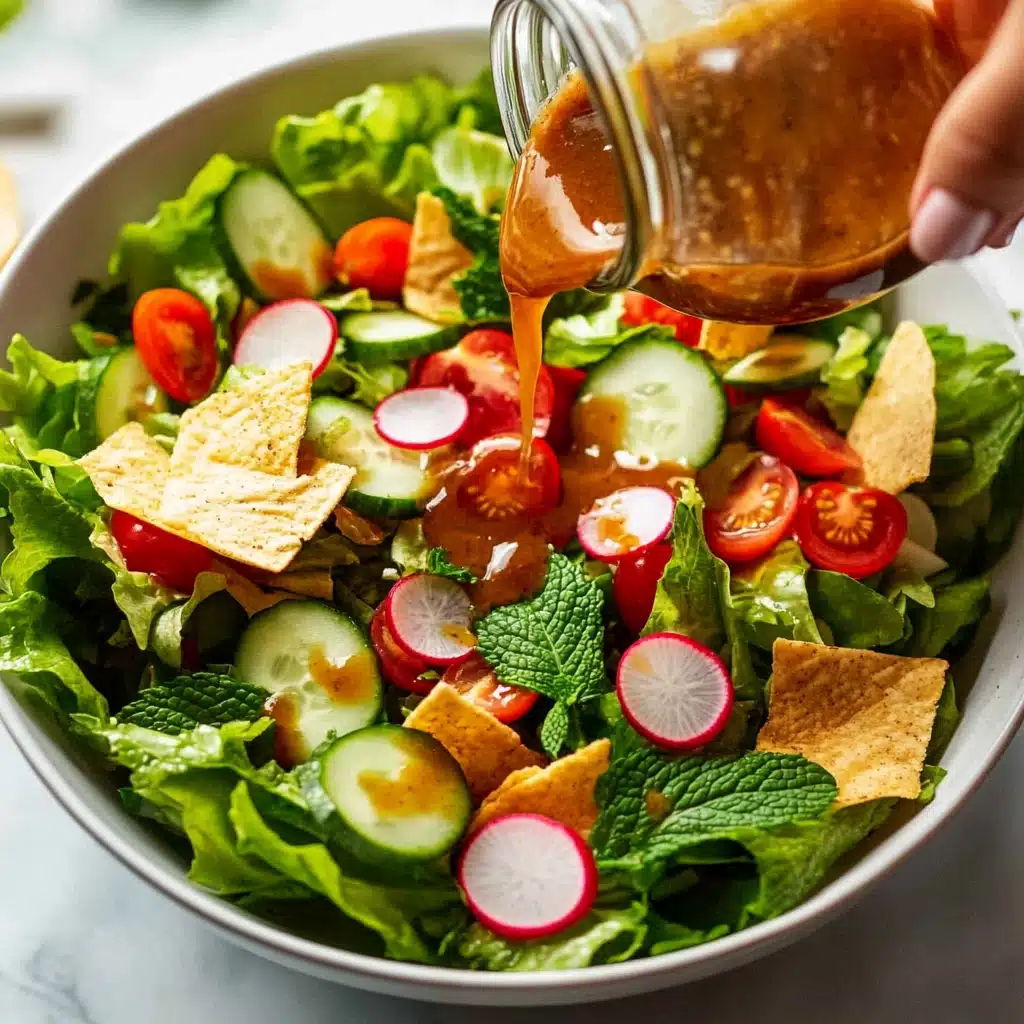
Ingredients You’ll Need
The beauty of Lebanese Fattoush lies in its bright, everyday ingredients that come together to make something extraordinary. Each component adds a unique pop of flavor, crunch, or color, and there’s truly no fussy technique required here—just fresh, quality items and a little prep.
- Pita bread or Lebanese bread: These transform into golden, crispy croutons that make fattoush so craveable—homemade is a must here!
- Olive oil and salt: Essential for toasting the pita, giving it a rich, savory crunch.
- Cos or romaine lettuce: Sturdy, sweet crunch forms the fresh salad base.
- Lebanese cucumbers: Slightly sweeter, thinner-skinned cucumbers that don’t require peeling—though any crisp cucumber will work.
- Cherry tomatoes: Little flavor bombs that add juicy sweetness, but larger tomatoes cut into chunks are great, too.
- Red onion: Thinly sliced for just the right sharpness and vibrant color.
- Red radish: Adds pretty pink slices and peppery bite—it’s a favorite in authentic Lebanese Fattoush.
- Fresh mint and parsley: Fragrant herbs that elevate every mouthful; don’t skip the mint!
- Extra-virgin olive oil: The backbone of the lush, silky dressing.
- Lemon juice: Brightens up the salad and balances the savory notes.
- Pomegranate molasses: This secret ingredient adds a sweet-tart depth—irreplaceable for true Lebanese Fattoush flavor.
- Fresh garlic: Just a touch amps up the tangy dressing.
- Sumac: Brings a gorgeous ruby-red color and citrusy, almost floral zing; it’s classic, but still worth making the salad even if you can’t find it.
- Cooking salt / kosher salt: Enhances every element, from the pita chips to the veggies and dressing.
Variations
The magic of Lebanese Fattoush is that it’s truly a “whatever’s in the fridge” kind of salad, so never be afraid to play! Whether you need a gluten-free swap, want extra veggies, or need to suit a vegan guest, these variations prove how wonderfully flexible this dish can be.
- Try different greens: Swap romaine for mixed baby greens or even crisp iceberg if that’s what you have on hand.
- Add more seasonal veggies: Diced bell peppers, sliced green onions, or even a sprinkle of sweet corn can be delicious.
- Gluten-free Fattoush: Use gluten-free pita or toss in your favorite GF crackers for a similar crunch.
- Vegan all the way: It’s naturally vegan—just make sure your pita bread is dairy-free!
How to Make Lebanese Fattoush
Step 1: Make the Crispy Pita “Croutons”
Start by preheating your oven to 220°C/425°F (or 200°C for fan-forced ovens). Split each pita bread into two thin rounds, then cut them into generous 3cm squares. Toss with olive oil and a pinch of salt, and spread the pieces out on a baking tray. Bake for around 5 minutes until deep golden and gorgeously crisp, then set aside to cool. These addictive bites are what make Lebanese Fattoush so special!
Step 2: Prepare the Dressing
In a small jar (or a bowl with a whisk), combine extra virgin olive oil, lemon juice, pomegranate molasses, finely crushed garlic, sumac, and a good pinch of salt. Give it all a vigorous shake (or whisk) so the dressing emulsifies and the flavors blend—taste and adjust if needed. This tangy, luscious dressing is a big part of what sets Lebanese Fattoush apart from every other salad on your dinner table.
Step 3: Assemble the Salad
Add your romaine lettuce, cucumber slices, cherry tomato halves, finely sliced red onion, radishes, fresh mint, and parsley to a large bowl. Drizzle over half the vibrant dressing, then gently toss so all the greens are beautifully coated without bruising. Sprinkle in most of your crispy pita chips, add the rest of the dressing, and toss again to distribute everything evenly for that perfect Lebanese Fattoush bite.
Step 4: Serve and Enjoy
Transfer your Lebanese Fattoush to a beautiful serving platter or bowl, topping with the remaining pita chips. Serve immediately, before the croutons soften, and watch everyone dive in fork-first! The mix of crunch, freshness, and zesty dressing is simply unbeatable.
Pro Tips for Making Lebanese Fattoush
- Crispy Pita, Every Time: Spread the pita pieces in a single layer for even crisping—overcrowding leads to soft spots.
- Herb Magic: Use plenty of fresh mint and parsley for a salad that truly pops with fragrance; tuck a few leaves under your salad for a beautiful presentation, too.
- Sumac Substitute: If you can’t find sumac, add a pinch of extra lemon zest for a bit of citrus sparkle (but if you spot sumac, grab it—your Lebanese Fattoush will sing!).
- Assemble Last Minute: Always toss in the dressing and pita right before serving to keep the crunch factor sky-high—this is the secret to a truly irresistible fattoush!
How to Serve Lebanese Fattoush
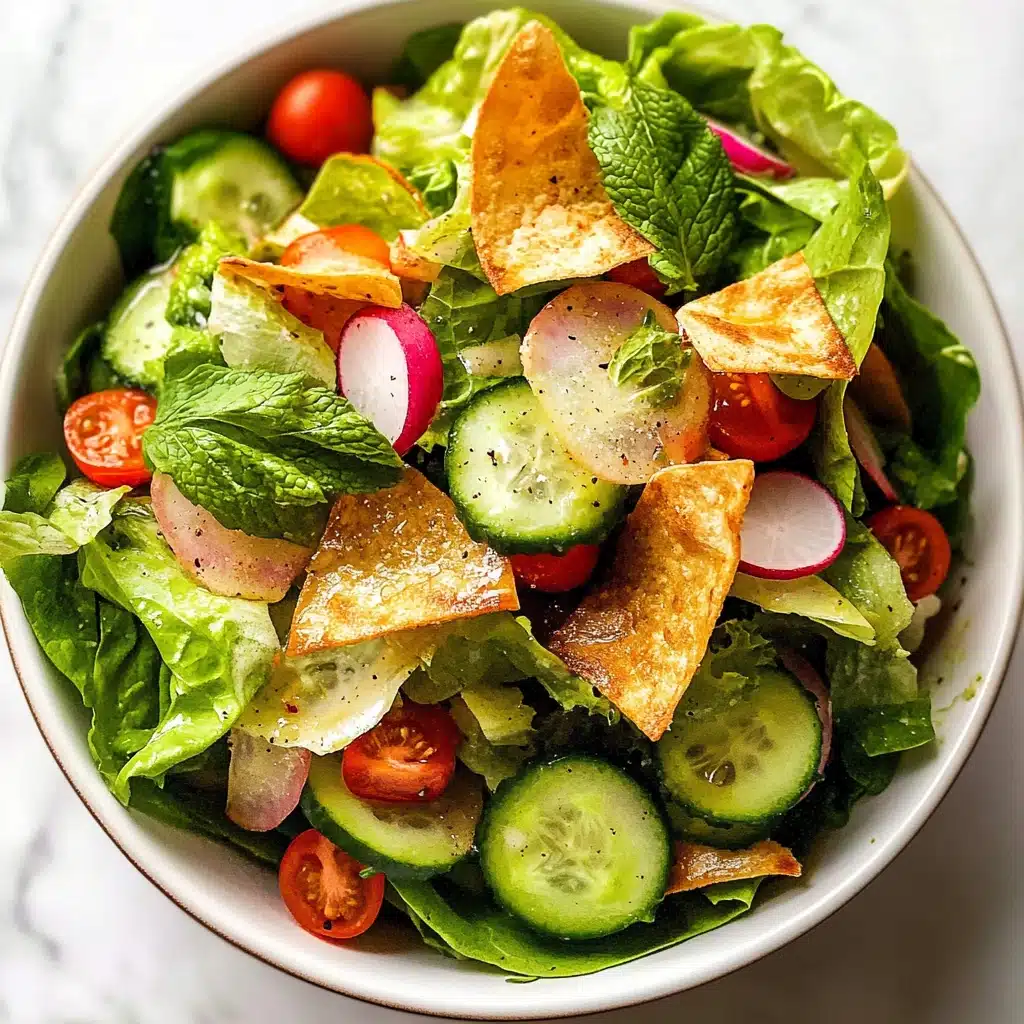
Garnishes
For classic Lebanese Fattoush, a sprinkle of extra sumac over the top adds color and tang. Scatter a few extra mint leaves or even edible flowers for a breathtaking look. I also love a drizzle of good extra-virgin olive oil right before serving for that irresistible Mediterranean sheen.
Side Dishes
Fattoush shines alongside just about any Middle Eastern spread—think creamy hummus, smoky baba ganoush, grilled meats or fish, or a platter of falafel. It’s also wonderful with a simple grilled chicken or as a vibrant topping for grain bowls.
Creative Ways to Present
Try serving Lebanese Fattoush in individual glasses for an appetizer, or layer it in wide, shallow bowls with extra pita chips for a build-your-own salad bar. For picnics or potlucks, pack the salad and pita separately, then toss them together just before enjoying for maximum crunch.
Make Ahead and Storage
Storing Leftovers
Dressed Lebanese Fattoush is best enjoyed fresh, as the pita chips soften quickly in the dressing. If you end up with leftovers, store the salad and crispy pita separately in airtight containers in the fridge; combine them just before serving for the best taste and texture.
Freezing
This salad doesn’t freeze well—fresh tomatoes, herbs, and cucumbers lose their crunch and vibrancy when thawed. The crispy pita chips, however, can be made ahead and frozen in an airtight bag for up to a month; simply re-crisp in the oven before using.
Reheating
There’s no need to reheat Lebanese Fattoush. If your pita chips have gone a bit soft, pop them in a hot oven for a minute or two to bring back the crunch before tossing into your salad. The rest is perfect enjoyed chilled straight from the fridge.
FAQs
-
What is the difference between Lebanese Fattoush and tabbouleh?
While both are iconic Lebanese salads, fattoush is built on crisp greens, seasonal veggies, and toasted pita chips, plus a tangy pomegranate-lemon dressing. Tabbouleh, in contrast, features heaps of fresh parsley and bulgur, with a more herb-focused, lemony profile and no pita.
-
Can I prep Lebanese Fattoush ahead of time for a party?
Absolutely! Chop all your veggies, mix the dressing, and toast the pita up to a day in advance. Store everything separately in airtight containers and simply toss them together just before serving so your salad keeps its signature crunch.
-
What can I use instead of pomegranate molasses?
If you can’t find pomegranate molasses, try a mix of extra lemon juice and a splash of good balsamic vinegar or even a touch of maple syrup for sweetness. The flavor won’t be exactly the same, but your Lebanese Fattoush will still be bright and delicious.
-
Is Lebanese Fattoush gluten-free?
Traditional Lebanese Fattoush is made with regular pita bread, but you can easily swap in your favorite gluten-free pita or flatbread to keep this salad perfectly gluten-free without losing that signature crunch.
Final Thoughts
If you’re looking for a salad that’s as joyful and crowd-pleasing as it is healthy, Lebanese Fattoush is the answer! I hope you give this recipe a whirl—let every crisp, herb-laden bite remind you how food can be both comforting and outrageously fresh. Enjoy every last crunch!
Print
Lebanese Fattoush Recipe
- Prep Time: 15 minutes
- Cook Time: 5 minutes
- Total Time: 20 minutes
- Yield: 5-6 servings
- Category: Salad
- Method: Baking, Mixing
- Cuisine: Lebanese
- Diet: Vegetarian
Description
Lebanese Fattoush is a fresh and vibrant salad featuring crispy pita bread croutons, mixed with a colorful array of vegetables and a tangy dressing. This recipe offers a delightful mix of textures and flavors that make it a perfect side dish or light meal.
Ingredients
Crispy pita bread ‘croutons’
- 2 pita bread or 1 Lebanese bread
- 2 tbsp olive oil
- 1/4 tsp cooking salt / kosher salt
Salad:
- 5 cups cos/romaine lettuce, cut into large bite-size pieces
- 2 Lebanese cucumbers, thinly sliced into 3mm rounds
- 1 cup cherry tomatoes, halved (~200g), or 1 1/2 regular tomatoes cut into large chunks
- 1/2 small red onion, thinly sliced
- 5 red radishes, finely sliced
- 1/2 cup mint leaves, lightly packed (large ones torn in half)
- 1 tbsp roughly chopped parsley
Dressing:
- 1/4 cup extra virgin olive oil
- 2 tbsp lemon juice
- 2 tsp pomegranate molasses
- 1 medium garlic clove, finely grated or crushed using garlic crusher
- 1 tsp sumac (optional)
- 1/2 tsp cooking salt / kosher salt
Instructions
- Crispy pita bread ‘croutons’
Preheat oven to 220°C/425°F (200°C fan-forced). Separate the pita bread into 2 thin sheets. Cut into 3cm / 1.2′ squares. Pile on a tray, drizzle with olive oil, toss, then sprinkle with the salt and toss again. Spread on the tray. Bake for 5 minutes or until crispy, then cool on the tray before use.
- Salad:
Dressing: Shake the dressing ingredients in a jar until well combined. Salad: Place the salad ingredients in a large bowl. Drizzle over half the dressing, toss. Add most of the crispy pita chips, drizzle with the remaining dressing and toss again. Serve: Transfer into a serving bowl, top with the remaining crispy pita and serve immediately.
Notes
- Storage – Dressed salad doesn’t really keep well. It’s best to eat freshly made. To make ahead, the dressing can be made the day before and stored in the fridge. Crispy pita can be baked ahead, cooled then stored in an airtight container for 24 hours. Salad ingredients can be chopped ahead and kept in a container (don’t toss). Then assemble just prior to serving.
- Inspired by various recipes found online including the Fattoush recipes by Zaatar and Zaytoun and the Guardian’s How to make the perfect fattoush.
Nutrition
- Serving Size: 1 serving
- Calories: 230 kcal
- Sugar: 5g
- Sodium: 450mg
- Fat: 15g
- Saturated Fat: 2g
- Unsaturated Fat: 11g
- Trans Fat: 0g
- Carbohydrates: 25g
- Fiber: 5g
- Protein: 4g
- Cholesterol: 0mg


